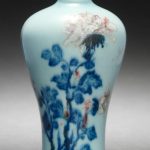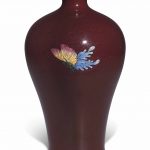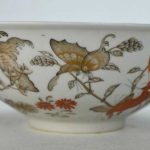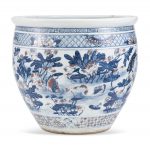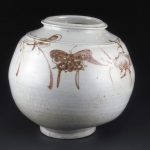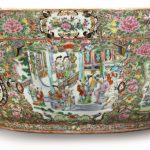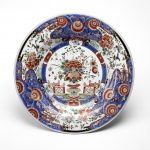Copper-red porcelain butterflies. Copper-red glazes are glazes containing copper which turn red when fired in a reducing atmosphere. The earliest known copper-red glaze occurs on wares made in Shanxi during the Tang dynasty. Jun kilns of the Song dynasty commonly used copper glazes. The sacrificial xianhong of the early Ming dynasty and its Qing dynasty copies, the Qing dynasty jihong (same but of the period), langyaohong, Peach-bloom and the Qing Jun red, which was really a monochrome red of the flambé type are all copper based red glazes. Reference: Gotheborg.com
Below are some examples of copper-red porcelain decorated with butterflies.
A copper-red and blue baluster vase, meiping Qianlong seal mark and of the period Painted around the exterior with a blossoming peony spray, with the leafy petals picked out in copper-red, with a pair of butterflies in flight, all beneath an even pale blue glaze. 13.1cm (5in) high.
Sold for £ 12,000 inc. premium at Bonhams in 2010
A FAMILLE ROSE COPPER-RED-GROUND ‘BUTTERFLY’ VASE, MEIPING 18TH-19TH CENTURY The vase is covered in a deep red glaze with flambé tones to the base and is decorated to one side in famille rose with an enamelled butterfly.
Sold for GBP 12,500 at Christies in 2017
19th C Chinese Gilt decorated Famille Rose Bowl w/Mark
CHINESE PORCELAIN
Bowl painted with light brown butterflies and copper red flowers on exterior, and branches of leaves on interior, 19th century. Seal mark. 3” x 7 1/4” dia.
Sold for $300 at The Popular Auction in 2013
A BLUE AND WHITE AND UNDERGLAZED-RED ‘CRANE AND LOTUS’ FISH JAR QING DYNASTY, 18TH – 19TH CENTURY with a tapered body rising from a flat base to an everted rim, beautifully painted in cobalt blue and copper red with a continuous scene depicting cranes in a lotus pond set with large blossoms and lotus pads, all below a frieze enclosing lotus blooms alternating with butterflies against a diapered ground, the rim further encircled by raised fillet and a key-fret border 41.7 x 45.8 cm, 16 3/8 by 18 in.
Sold for 112,500 HKD at Sothebys in 2016
Storage jar of porcelain, decorated with flowers and butterflies in copper red pigment under clear glaze
This storage jar dates to the late Cboson Period (1392-1910) and is decorated with a motif of flowers and butterflies in under-glaze copper red. Almost all extant examples of copper-decorated white porcelain date from the eighteenth century or later. Because of the greyish-white glaze and faint blue or green hue, it is believed to have been made in a local kiln. The technique of decorating ceramics with copper-red developed in Korea in the 12th century when it was used on celadon wares, but it was virtually unused in the making of white porcelain until the mid 18th century. Because of the unpredictability of copper, the colour would sometimes blur or turn green or brown after high-temperature firing.
Reference: © Victoria and Albert Museum

